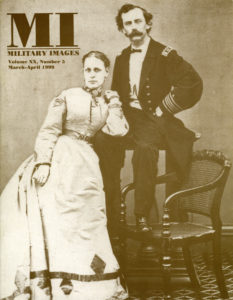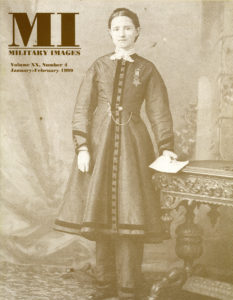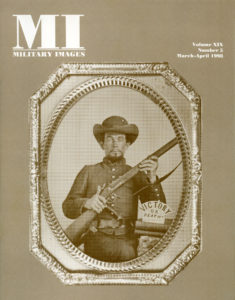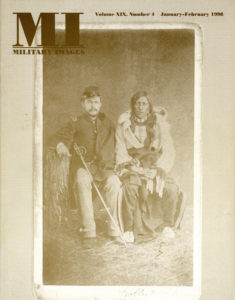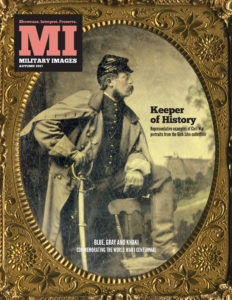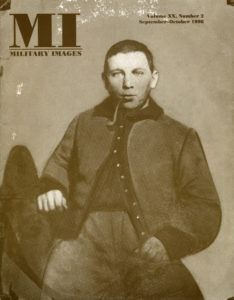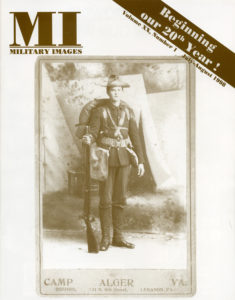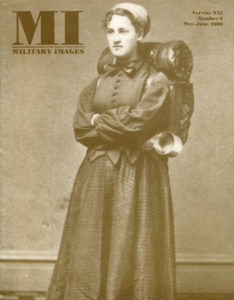The complete issue
Vol. XX, No. 5
(48 pages)
Print edition: Visit our store to check availability
Digital edition: Visit JSTOR.org to purchase
Subscribe to MI
Explore the MI Archives: Browse | Advanced search | Tutorial
Inside
Cover image
An image from the Jerry Harlowe Collection is a portrait taken in Hong Kong of a U.S. navy officer with the rank of commander who is posed with a woman who may be his wife or a British colonial subject.
Editor’s Desk (p. 3)
The editor notes that “national embarrassment” of the impeachment of President Bill Clinton is not as embarrassing as the first one 130 years ago, and shares a suggestion from Atlanta collector George Whiteley that we share plans for upcoming galleries so that readers can contribute.
Mail Call (pp. 4-7)
Letters include congratulations on the magazine’s 20th year in publication, the 93rd New York Infantry, the “Michigan” backdrop, German-American musicians, the Alabama, patriotic mats and more.
Cadets & Other Kids in Uniform (pp. 9-15)
A gallery of 25 photographs from the Civil War through World War I features cadets and children dressed in military costume.
Six from Sickles by John Sickles (pp. 16-21)
Profiles and portrait photographs of George Von Schack of the 7th New York Infantry, Robert Smalls of Planter fame, Henry M. Nevius of the 1st New York Cavalry, 7th Michigan Cavalry and 25th New York Cavalry, George Wehle of the 7th Kansas Cavalry, Jerome Napoleon Bonaparte, grandson of the French emperor’s youngest brother and his American-born wife and John A. Wilson of the Bragg.
Light & Shadow: Technical Aspects of Photography and Collecting (p. 21)
A list of photographic innovations of the Civil War, contributed by renowned collector William Gladstone.
An Obstinate Yankee Officer…Or, will the real Lt. Rogers please stand up? by Michael Hammerson (pp. 22-23)
A portrait of an unknown New York officer with a note inscribed on the back, “Miss Rogers, 182 N. Pearl St.,” is at the heart of a photo sleuthing mystery in progress by the author.
Famous Photograph…Recreated by Betty Cauler (pp. 24-25)
Confederate re-enactors in front of the J. Rosenstock storefront in downtown Harpers Ferry, W. Va., were photographed by the author. Her image is a recreation of an iconic 1862 image of the same spot.
Funerary Photography by Mark H. Dunkelman (pp. 26-28)
The author examines a Civil War era cemetery phenomenon of attaching photographs to grave markers. Two grave stones with indentations where the photographs once appeared illustrate the text.
Passing in Review (p. 29)
Three publications are mentioned, including Photographic History of the Civil War (10 volumes on two CD-ROMs) by H-Bar Enterprises, Private Soldiers and Public Heroes: An American Album of the Common Man’s Civil War (Rutledge Hill Press) by Milton Bagby and Life in Mr. Lincoln’s Navy (Naval Institute Press) by Dennis J. Ringle.
Two Pair: Vignettes from the collection of James J. Hennessey (pp. 30-31)
Profiles of two Union soldiers, each represented by two unique portraits, include Fife Major Bradford Wakeman of the 33rd Illinois Infantry and Capt. Elias Pellet of the 17th and 114th New York Infantry.
The Dandy 7th: A selection of photos of the 7th Regiment, New York State Militia in the collection of David O’Reilly (pp. 32-35)
A gallery of 11 portraits of this much-photographed regiment includes Samuel Curtis, James Ray, Joseph Lentilhan, Alfred Cutler Barnes, James Benkard, H.T. Teer and W.B. Allen.
Uniforms & History by Michael J. McAfee (pp. 36-37)
In “The Seventh Regiment, National Guard, State of New York, The Chasseur Uniform, 1865-1867,” McAfee examines the elaborate uniforms and headgear of the unit. Two cartes de visite, one of an enlisted man and another of two officers, illustrate the text.
Captain Bob’s Caveat Emptorium (p. 39)
Though still in the Witness Protection Program, Bob makes mischief from afar with images he is trying to pawn off as Confederate prisoners of war. But we know better.
Stragglers (pp. 40-45)
Solo photos of the odd, the unusual and the humorous from the collections of our readers includes an array of 21 photographs that include groupings of soldiers at play, bandsman and other subjects.
Sutler’s Row (pp. 46-47)
Back cover
A sixth-plate ambrotype from the Roy Mantle Collection is described as a “new volunteer with his bonnie lady.”
